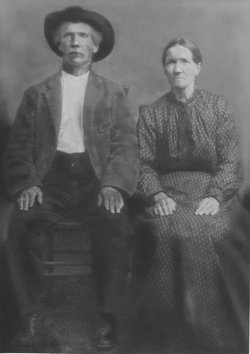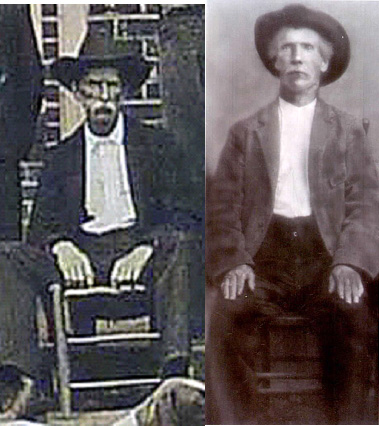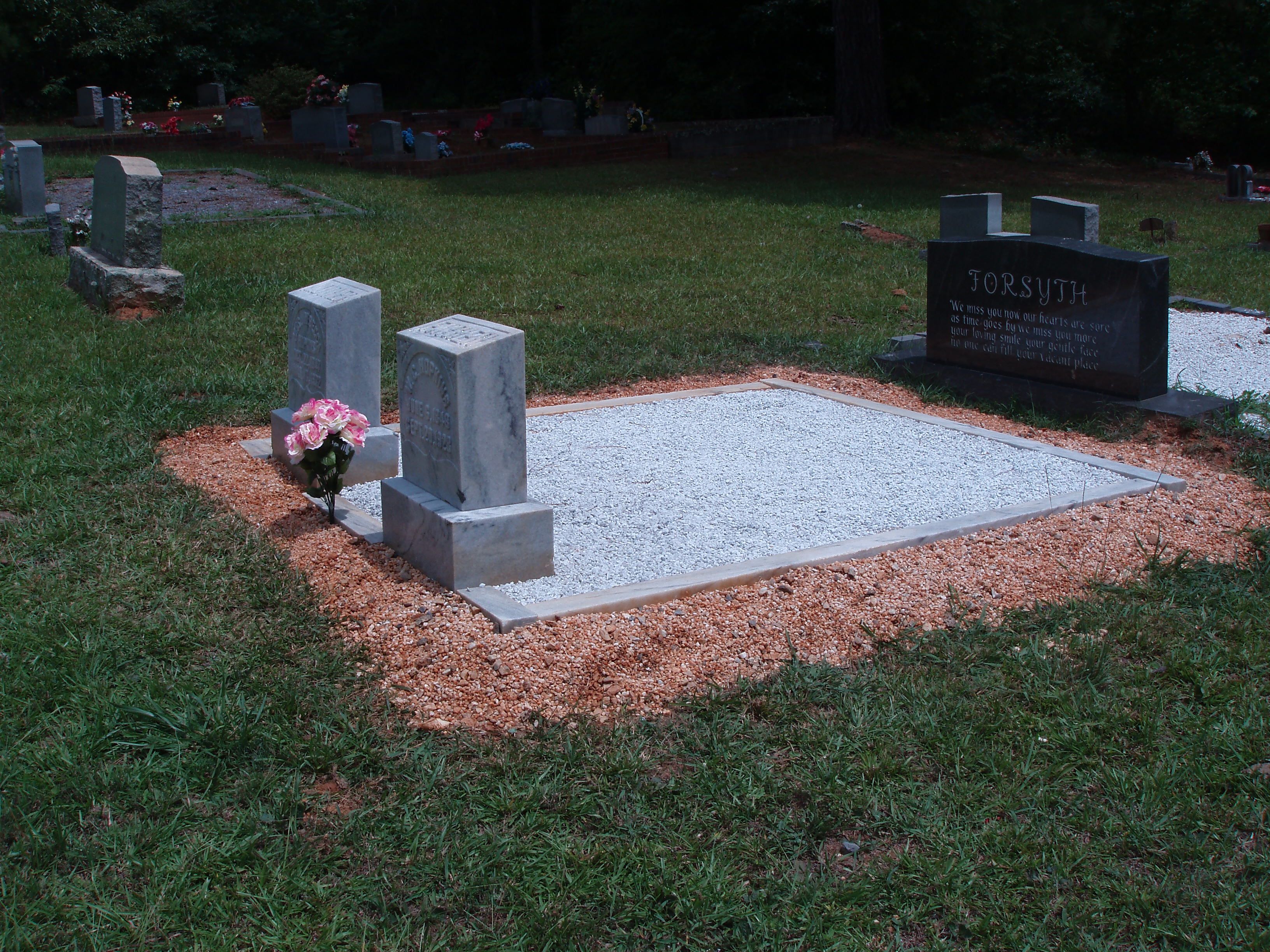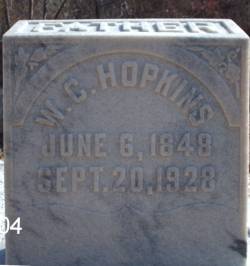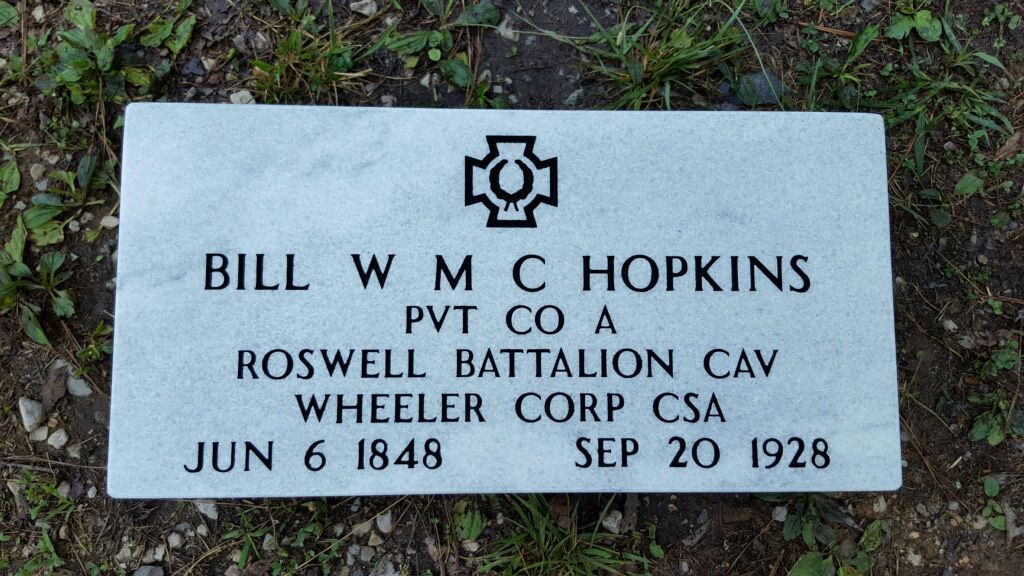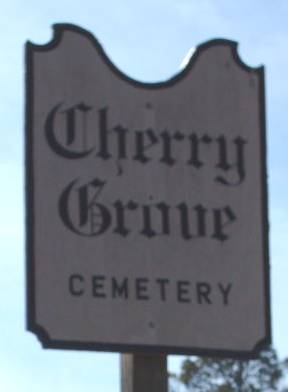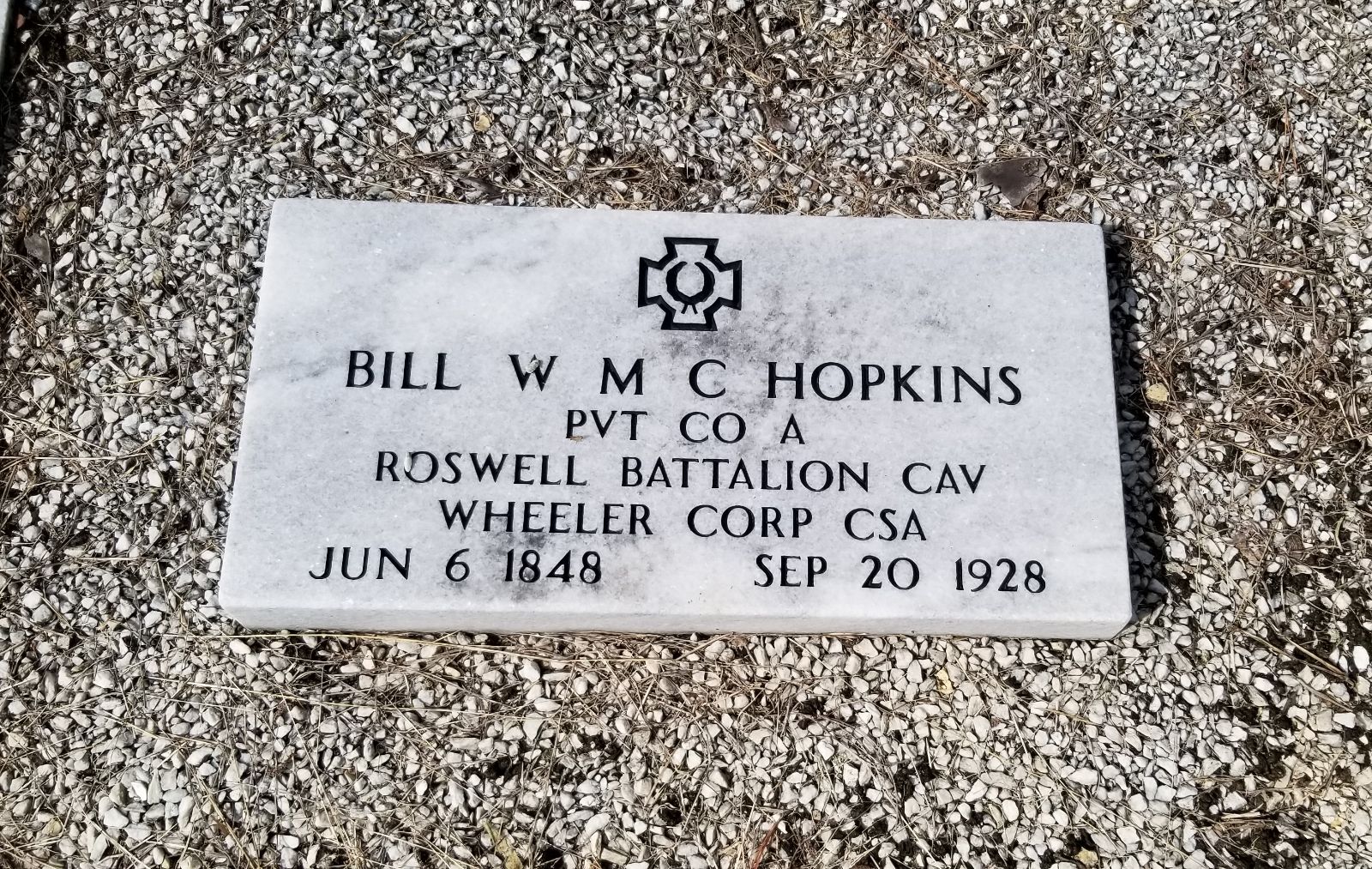"Wild Bill" William Charles Marion Hopkins states he was in the Roswell Battalion, 24th Alabama Regiment and 53rd Aiabama Regiment in his pension and the 1921 Alabama Conferdate census..
In a brief history of the "Roswell Battalion", Georgia Cavalry of Confederate States of American, written soon after the war, it is related, "The sun shone brightly on the morning of the 5th July 1864, as down the picturesque clay road of the little village of Roswell, could be seen a part of horsemen. The clank of sabers, rattle of spurs, and grey uniforms proclaimed them a company of Confederate cavalry. This was the "Roswell Battalion" numbering 75 handpicked men, brave and true, ready to do or die for home and country. Onward they went towards the river, with merry jests and hopeful hearts, prefect confidence in their Commander and faith in the practice of the Cause they espoused. Passing over the Chattahoochee River, they halted by word of command of (illegible) and quietly and deliberately burned the bridge behind them." "History of the 53rd Regment Alabama Volunteer Cavalry," by Robert G. McLendon, Jr. On 22 July 1864 in the "Battle of Atlanta, near Decatur Georgia in a cavalry charge, Billy was shot in the forehead by the invading Yankees. He continued to fight until the end of the battle. The men of "Roswell Battalion" were with the 24th Alabama Cavalry Regiment, the 53th Alabama Cavalry Regiment and the 11th Georgia Cavalry. All four cavalry units formed the "Hannon's Brigade " served in the Confederate States of America, Army of Tennessee under General Joseph Wheeler's Cavalry Corps. They fought against General Sherman army during, "March to the Sea" and the "Carolinas Campaign", almost every day for the next 308 days until 9 May 1865 in August Georgia, they were paroled by orders from Col Moses Wright Hannon, seized by the Federals and force to take the Oath Of Allegiance. It was a bitter pill, far worse than rhubarb, falap, or any other bad medicine. However, they managed to swallow it down and immediately turned their faces homewards rejoicing on the way. Little did they know only 14 men would survive the battles and return to Roswell, two of these men were my great great grandfather George W. Hopkins and my great grandfather William Charles Marion Hopkins, aka "Wild Billy".
————————————————
I read several articles that the Roswell Battalion was just a "Rag Tag Outfit". It is my family's "Rag Tag Outfit". They were placed in the regular cavalry and did their Duty.
Hannon's Brigade was the smallest Brigade in Wheeler's cavalry and Roswell Battalion was smallest battalion in Hannon's Brigade.
I have ID 179 men 20 of them were deserters. (159)
I also found:
Co. A 81
Co. B 46
Co. C 34
Total: (161)
Google: Jshop24, Geocities, to see the Rosters of the "Roswell
Battalion" and the "Roswell Guards". **
** In the mid-1990s, the World Wide Web (as it was called at the time) was a new frontier.
Geocities hosted over 40 million websites before it closed. The primary factors was profitability and technological issues.
They selected 100,000 GeoCities websites to be saved which have been archived for posterity by oocities.org.
My Jshop24 website was one of the 100,000 to be saved. I have some information wrong on my website but I can not edit it because it's frozen. My email address is [email protected]
The battalion was organized on June 28, 1863. "This company is organized for home defense to protect the portion of the state of Georgia lying north of Atlanta to the Alabama and Tennessee lines (under the Act of Congress for home defense), not to be called upon except to repel a raid of the Yankees and not to be kept on service longer than is necessary for that special purpose. A large portion are composed of detailed men now at work for the Confederate State Government under Major G.W. Cunningham, Q.M. for Atlanta at Roswell Factories, 20 miles north of Atlanta. It is composed of men and boys from 60 years down to 16 years of age." "This company was originally a battalion of Infantry, Cavalry, and Artillery, organized for local defense and composed principally of the men detailed to operate the cotton and woolen mills at Roswell, Cobb County, Georgia. Having been ordered into field service at the evacuation of Marietta by our forces, a number of the men deserted: after which the Captain Commanding the battery was ordered to turn over the artillery and mount the remainder of the men, they mounting themselves."
Captain James Roswell King organized the Roswell Battalion at his own expense to defend the area around Factory town (Roswell Village). It was organized for home defense, to only be called upon to repel a raid of the Yankees.
In a brief history of the Roswell Battalion written soon after the war, it is related, "The sun shone brightly on the morning of the 5th of July 1864 as picturesque red clay road of the little village of Roswell, could be seen a part horsemen, the clank of sabers, rattle of spurs and grey uniforms proclaimed them a company of Confederate cavalry. (They probably were wearing brand new uniforms made in the Roswell Mill.)This was the Roswell Battalion (Company "A") numbering 75 handed picked men, brave and true, ready to do or die for home and country. Onward they went towards the river, with merry jests and hopeful hearts, perfect confidence in their Commander and faith in the practice of the Cause they espoused. Passing over the Chattahoochee River, they halted by word of command of (illegible) and quietly and deliberately burned the bridge behind them."
Of the 75 men originally assigned to the Roswell Battalion company A, on 5th July 1864 only 14 remained left to surrender on 3rd May 1865 in Augusta Georgia and two of them were my great grandfather "Wild Billy" William Charles Marion Hopkins and his dad, my great great grandfather George W. Hopkins.
05 July 1864 they were called, at 11:00 am the Roswell Battalion company A, rode south out of town of Roswell (company B and company C the Artillery must marched over the bridge earlier) crossed the covered bridge at the Chattahoochee River, and the continued south after burning the bridge by orders from Captain King and fighting with Hannon's Brigade. (Did not find any more information on company C)
The exact date of the assignment of the Roswell Battalion to Hannon's Brigade has not been determined, but their service closely parallels of Hannon's Brigade from 5 July 1864 until the end of the war.
06-10 July - Action along Chattahoochee River
08 July - Skirmish near Isham's Ford on the Chattahoochee River
09 July - Shallow Ford on Chattahoochee River at Roswell Skirmish at McAfee's Bridge on the Chattahoochee River
10 July - Action at Campbellton Georgia
12 July - Action on the Chattahoochee River
14 July - Skirmish near Roswell Georgia at McAfee's Bridge
15 July - Skirmish at Stone Mountain Road Georgia
16-19 July - Actions on the Decatur Road
17 July - Skirmish at Buckhead Georgia
18 July – Skirmish near Decatur Georgia
18 July – Skirmish at the railroad crossing
19-22 July - Engagement at Decatur Georgia
19 July - Skirmish at Georgia Railroad
19-20 July - Engagement at Peachtree Creek
20 July - Skirmish near Atlanta Georgia
20 July - Battle of Peachtree Creek Georgia
22 July - Action at Mill Road Georgia
22 July - Battle of Atlanta, near Decatur Georgia, my great grandfather "Wild Billy" William Charles Marion Hopkins was shot in the forehead by the invading Yankees but continued fight in the battle.
23 July - Skirmish on Georgia Railroad
25 July - Skirmish on Hardee's right at Atlanta
26 July - Skirmish at Swamps Georgia
27-31 July – Engagement with Garrard's cavalry at Flat Rock and Lithonia Station during McCook/Stoneman raid, or picketing on the Chattahoochee River.
July had proven to be a costly month for Hannon's Brigade, as they continued to be engaged almost on a daily basis and suffered many casualties.
10 August – Wheeler left from the area of Covington in the direction of Dalton for a raid behind Sherman's lines. Hannon's Brigade was designated as the lead force.
11 August – Camped on the banks of the Chattahoochee River.
14 August – 6 am, Hannon's Brigade attacked the Federal command guarding a beef cattle and supply train. They captured the cattle and supply train, four miles north of Adairsville and five miles south of Calhoun. They drove the 2500 head of cattle by way of Ellijay, Dahlonega, Athens, Greensboro, and Milledgeville to Macon Georgia.
Roswell Battalion Company B, numbering 46 composed of youths between fifteen and eighteen years of age was mustered into Georgia State Reserves service 1st September 1864, by Captain King.
Hannon's Brigade remained in the area of Atlanta, with the mission of watching Sherman's Army, still occupying Atlanta.
The GA 30th Cavalry Battalion was organized in May 1864 in Athens, GA, became the 11th Regiment Georgia Volunteer Cavalry.
12 October 1864, 11th Regiment Georgia Cavalry added to Hannon's Brigade.
Colonel Hannon verbally promoted to Brigadier General by General Hood.
"Savannah Campaign"
November 15 – December 21, 1864
Fights/Skirmish
09 November near Jonesboro
15 November Sherman's Army leaves Atlanta.
15 November Jonesboro
16 November Lovejoy Station
16 November Bear Creek
17 November Towaliga
18 November Run's Creek
19 November Ulcofaw
20 November Near Macon
20 November Walnut Creek
21 November Griswoldville
22 November Myrick's Mill
24 November Ball's Ferry
25 November Oconee
25 November Sandersville
26 November Ogreechee
27 November Sylvan Grove
27 November Swampy Creek
27 November River Creek
27 November Hill, Georgia
27 November Whitehead's
27 November Near Waynesboro
28 November Near Waynesboro
04 December Waynesboro
When Sherman entered Savannah, Hannon's Brigade was camped near Springfield, Effingham County and in the area of Burke County Georgia.
Our pickets were nearly constantly engaging the enemy's scouting parties and foragers.
01 December Millen (Shady Grove)
02 December Rocky Creek
03 December Thomas Station
04 December Waynesboro
05 December Statesborough
07 December Black Creek
10-21 December siege of Savannah
Hannon's Brigade was on Georgia side of the Savannah River.
30th December Sherman army started crossing the Savannah River at a point a little above Sister's Ferry.
January Hannon's Brigade was actively engaged as scouts and on picket duty from Sister's Ferry on the Savannah River, to the mouth of the Altamaha River, could not be inspected because being too distant and scattered that they could not be reached.
"Carolina's Campaign's"
February 1864 - April 26 1865
04 February 1865 "I congratulate you on the gallantry of Hannon's Brigade and his men." General D. H. Hill to General Alfred Iverson.
11 February 1865 Wheeler whips Kilpatrick at Aiken South Carolina.
14 February 1865 Hannon's Brigade cross the Savannah River to report to Aiken South Carolina, to picket all approaches to Augusta Georgia.
09 March 1865 Hannon's Brigade camped near Aiken at Graniteville, at a large factory and picketing along the Savannah River for the next several weeks.
24th Alabama return to vicinity of Millen Georgia for picket duty for several weeks.
25 March 1865 Hannon's Brigade was station in area of Burke County Georgia.
12 April 1865 General Young enter Columbia South Carolina.
14 April 1865 the rest of Young's division enter Columbia South Carolina.
15 April 1865 Hannon's Brigade was ordered to Messer's Mill and remained there until the 17th. (near Lang's Mill on the road to Camden)
16th April 1865 Young do not move Hannon's Brigade too far from Camden South Carolina. (principally armed with Enfield rifles)
17th April 1865 at 6:00 pm, reached the Wateree Ferry, two miles from Camden South Carolina, enemy in Camden and approaching the ferry, Young moved his force sixteen miles below the west bank of the Wateree River, crossed the river at Sumter's Landing near General Thomas Sumter's home, made his headquarters at "Dixie Hall", the plantation of William Sanders which was located between Sumter's Landing and Boykin's Mill.
18 April 1865 Skirmish at Boykin's Mill Hannon's Brigade was three miles in rear near DeSaussure's plantation.
19 April 1865 taking position again on the opposite at Dinkin's Mill on Little Rafting Creek, then regroup on top of hill where the "Church of the Holy Cross" stands at Stateburg South Carolina. (there was a creek named "Beech Creek" at the foot hill about half mile from the church).
21 April 1865 Hannon's Brigade crossed over the Wateree River at the railroad trestle below Middleton moving back to Columbia South Carolina.
While in Columbia General Robert E. Lee order was read to the troops that all east of the Chattahoochee River was surrendered and they received orders to report to Augusta Georgia to deliver up all Confederate property.
03 May 1865 they were seized by the Federals, forced to the commandant's office mustered out of service with an honorably discharged.
04 May 1865 the day at 10 o'clock in the morning they were paroled by forced to take the prescribed Oath of Allegiance, a day long to be remembered by every soldier of Hannon's Brigade. (My great grandfather Bill's pension says May 8th or 9th and he fought in 53rd and in 24th. In 1921 Confederate Census of Alabama he says he fought in the 53rd.) It was a bitter pill, far worse than rhubarb, falap, or any bad medicine. However, they managed to swallow it down and immediately turned their faces homeward bound.
No men in the Confederate States have marched more, (303 days) fought more, suffered more or had so little opportunities for discipline, yet they are today as orderly and as well-disciplined as any cavalry in the Confederate Service.
Most of information here is from "History of 53rd Regiment Alabama Volunteer Cavalry", by Robert G. McLendon, Jr.
A salute to Robert G. McLendon, Jr., he also has a few copies of his book left for purchase.
George and "Wild Billy" Hopkins might not be in every skirmish listed but they were in area of engagements.
Hannon's Brigade saw perilous duty throughout the Atlanta Campaign, and was one of the primary cavalry forces opposing William T. Sherman Army during his infamous "March to the Sea" and the "Carolina's".
Since July Hannon's Brigade continued to be engaged almost on a daily basis and suffered many casualties. Sherman lost almost 2,100 men in the March to the Sea. The Confederate losts was about 1,000 and the one Battle of Griswoldville lost 650 little boys, teenaged boys, and old men. Yankees lost 62 in the battle.
Sherman said: more than one occasion, during and after the war, that Wheeler and his cavalry gave him more trouble than all other Confederates.
Poem
Hannon's Volunteer Cavalry Brigade, "Partisan Rangers", Wheeler Cavalry Corp of the Army of Tennessee
Confederate States of America
We took our men from the backwoods, the South Alabama plains, the piedmont, the Georgia mountains and the Roswell Mill.
The 53rd Alabama, 24th Alabama, later join by the Roswell Battalion and 11th Georgia all Cavalry.
The clanking of sabers, rattle of spurs and Grey uniforms proclaim them "Partisan Rangers", men brave and true, ready to do or die for Home and Country.
We put them under orders "Guerrilla Fighting Orders", then the regular cavalry, what we lack in numbers, we made up in Speed and Determination.
Rebs, Yankees, Sherman, and Strangers a like, they called us "Partisan Rangers".
My name is Brigadier General Moses W. Hannon commander of the Hannon's Brigade "Partisan Rangers" Wheeler Cavalry Corp of the Army of Tennessee Confederate States of America!!!
My name is Jack S. Hopkins and proud of all my Confederate family members.
One odd thing I discovered was my father's grandfather "Wild Billy" William Marion Charles Hopkins and his great grandfather George W. Hopkins was fighting Sherman's army on the end of his left flank at the Roswell bridge in Roswell Georgia.
My mother's great grandfather Robert R. Moore and her great great grandfather William W. Moore was fighting Sherman's army on the end of his right flank at the Moore's bridge at Whitesburg Georgia. The Moore's bridge was own by William's brotherJames Dolphin Moore and today what's left of his plantation 485 acres has been turn into the "Moore's Bridge Park".
If I have stated anything wrong let me know and I can change it.
"Wild Bill" William Charles Marion Hopkins states he was in the Roswell Battalion, 24th Alabama Regiment and 53rd Aiabama Regiment in his pension and the 1921 Alabama Conferdate census..
In a brief history of the "Roswell Battalion", Georgia Cavalry of Confederate States of American, written soon after the war, it is related, "The sun shone brightly on the morning of the 5th July 1864, as down the picturesque clay road of the little village of Roswell, could be seen a part of horsemen. The clank of sabers, rattle of spurs, and grey uniforms proclaimed them a company of Confederate cavalry. This was the "Roswell Battalion" numbering 75 handpicked men, brave and true, ready to do or die for home and country. Onward they went towards the river, with merry jests and hopeful hearts, prefect confidence in their Commander and faith in the practice of the Cause they espoused. Passing over the Chattahoochee River, they halted by word of command of (illegible) and quietly and deliberately burned the bridge behind them." "History of the 53rd Regment Alabama Volunteer Cavalry," by Robert G. McLendon, Jr. On 22 July 1864 in the "Battle of Atlanta, near Decatur Georgia in a cavalry charge, Billy was shot in the forehead by the invading Yankees. He continued to fight until the end of the battle. The men of "Roswell Battalion" were with the 24th Alabama Cavalry Regiment, the 53th Alabama Cavalry Regiment and the 11th Georgia Cavalry. All four cavalry units formed the "Hannon's Brigade " served in the Confederate States of America, Army of Tennessee under General Joseph Wheeler's Cavalry Corps. They fought against General Sherman army during, "March to the Sea" and the "Carolinas Campaign", almost every day for the next 308 days until 9 May 1865 in August Georgia, they were paroled by orders from Col Moses Wright Hannon, seized by the Federals and force to take the Oath Of Allegiance. It was a bitter pill, far worse than rhubarb, falap, or any other bad medicine. However, they managed to swallow it down and immediately turned their faces homewards rejoicing on the way. Little did they know only 14 men would survive the battles and return to Roswell, two of these men were my great great grandfather George W. Hopkins and my great grandfather William Charles Marion Hopkins, aka "Wild Billy".
————————————————
I read several articles that the Roswell Battalion was just a "Rag Tag Outfit". It is my family's "Rag Tag Outfit". They were placed in the regular cavalry and did their Duty.
Hannon's Brigade was the smallest Brigade in Wheeler's cavalry and Roswell Battalion was smallest battalion in Hannon's Brigade.
I have ID 179 men 20 of them were deserters. (159)
I also found:
Co. A 81
Co. B 46
Co. C 34
Total: (161)
Google: Jshop24, Geocities, to see the Rosters of the "Roswell
Battalion" and the "Roswell Guards". **
** In the mid-1990s, the World Wide Web (as it was called at the time) was a new frontier.
Geocities hosted over 40 million websites before it closed. The primary factors was profitability and technological issues.
They selected 100,000 GeoCities websites to be saved which have been archived for posterity by oocities.org.
My Jshop24 website was one of the 100,000 to be saved. I have some information wrong on my website but I can not edit it because it's frozen. My email address is [email protected]
The battalion was organized on June 28, 1863. "This company is organized for home defense to protect the portion of the state of Georgia lying north of Atlanta to the Alabama and Tennessee lines (under the Act of Congress for home defense), not to be called upon except to repel a raid of the Yankees and not to be kept on service longer than is necessary for that special purpose. A large portion are composed of detailed men now at work for the Confederate State Government under Major G.W. Cunningham, Q.M. for Atlanta at Roswell Factories, 20 miles north of Atlanta. It is composed of men and boys from 60 years down to 16 years of age." "This company was originally a battalion of Infantry, Cavalry, and Artillery, organized for local defense and composed principally of the men detailed to operate the cotton and woolen mills at Roswell, Cobb County, Georgia. Having been ordered into field service at the evacuation of Marietta by our forces, a number of the men deserted: after which the Captain Commanding the battery was ordered to turn over the artillery and mount the remainder of the men, they mounting themselves."
Captain James Roswell King organized the Roswell Battalion at his own expense to defend the area around Factory town (Roswell Village). It was organized for home defense, to only be called upon to repel a raid of the Yankees.
In a brief history of the Roswell Battalion written soon after the war, it is related, "The sun shone brightly on the morning of the 5th of July 1864 as picturesque red clay road of the little village of Roswell, could be seen a part horsemen, the clank of sabers, rattle of spurs and grey uniforms proclaimed them a company of Confederate cavalry. (They probably were wearing brand new uniforms made in the Roswell Mill.)This was the Roswell Battalion (Company "A") numbering 75 handed picked men, brave and true, ready to do or die for home and country. Onward they went towards the river, with merry jests and hopeful hearts, perfect confidence in their Commander and faith in the practice of the Cause they espoused. Passing over the Chattahoochee River, they halted by word of command of (illegible) and quietly and deliberately burned the bridge behind them."
Of the 75 men originally assigned to the Roswell Battalion company A, on 5th July 1864 only 14 remained left to surrender on 3rd May 1865 in Augusta Georgia and two of them were my great grandfather "Wild Billy" William Charles Marion Hopkins and his dad, my great great grandfather George W. Hopkins.
05 July 1864 they were called, at 11:00 am the Roswell Battalion company A, rode south out of town of Roswell (company B and company C the Artillery must marched over the bridge earlier) crossed the covered bridge at the Chattahoochee River, and the continued south after burning the bridge by orders from Captain King and fighting with Hannon's Brigade. (Did not find any more information on company C)
The exact date of the assignment of the Roswell Battalion to Hannon's Brigade has not been determined, but their service closely parallels of Hannon's Brigade from 5 July 1864 until the end of the war.
06-10 July - Action along Chattahoochee River
08 July - Skirmish near Isham's Ford on the Chattahoochee River
09 July - Shallow Ford on Chattahoochee River at Roswell Skirmish at McAfee's Bridge on the Chattahoochee River
10 July - Action at Campbellton Georgia
12 July - Action on the Chattahoochee River
14 July - Skirmish near Roswell Georgia at McAfee's Bridge
15 July - Skirmish at Stone Mountain Road Georgia
16-19 July - Actions on the Decatur Road
17 July - Skirmish at Buckhead Georgia
18 July – Skirmish near Decatur Georgia
18 July – Skirmish at the railroad crossing
19-22 July - Engagement at Decatur Georgia
19 July - Skirmish at Georgia Railroad
19-20 July - Engagement at Peachtree Creek
20 July - Skirmish near Atlanta Georgia
20 July - Battle of Peachtree Creek Georgia
22 July - Action at Mill Road Georgia
22 July - Battle of Atlanta, near Decatur Georgia, my great grandfather "Wild Billy" William Charles Marion Hopkins was shot in the forehead by the invading Yankees but continued fight in the battle.
23 July - Skirmish on Georgia Railroad
25 July - Skirmish on Hardee's right at Atlanta
26 July - Skirmish at Swamps Georgia
27-31 July – Engagement with Garrard's cavalry at Flat Rock and Lithonia Station during McCook/Stoneman raid, or picketing on the Chattahoochee River.
July had proven to be a costly month for Hannon's Brigade, as they continued to be engaged almost on a daily basis and suffered many casualties.
10 August – Wheeler left from the area of Covington in the direction of Dalton for a raid behind Sherman's lines. Hannon's Brigade was designated as the lead force.
11 August – Camped on the banks of the Chattahoochee River.
14 August – 6 am, Hannon's Brigade attacked the Federal command guarding a beef cattle and supply train. They captured the cattle and supply train, four miles north of Adairsville and five miles south of Calhoun. They drove the 2500 head of cattle by way of Ellijay, Dahlonega, Athens, Greensboro, and Milledgeville to Macon Georgia.
Roswell Battalion Company B, numbering 46 composed of youths between fifteen and eighteen years of age was mustered into Georgia State Reserves service 1st September 1864, by Captain King.
Hannon's Brigade remained in the area of Atlanta, with the mission of watching Sherman's Army, still occupying Atlanta.
The GA 30th Cavalry Battalion was organized in May 1864 in Athens, GA, became the 11th Regiment Georgia Volunteer Cavalry.
12 October 1864, 11th Regiment Georgia Cavalry added to Hannon's Brigade.
Colonel Hannon verbally promoted to Brigadier General by General Hood.
"Savannah Campaign"
November 15 – December 21, 1864
Fights/Skirmish
09 November near Jonesboro
15 November Sherman's Army leaves Atlanta.
15 November Jonesboro
16 November Lovejoy Station
16 November Bear Creek
17 November Towaliga
18 November Run's Creek
19 November Ulcofaw
20 November Near Macon
20 November Walnut Creek
21 November Griswoldville
22 November Myrick's Mill
24 November Ball's Ferry
25 November Oconee
25 November Sandersville
26 November Ogreechee
27 November Sylvan Grove
27 November Swampy Creek
27 November River Creek
27 November Hill, Georgia
27 November Whitehead's
27 November Near Waynesboro
28 November Near Waynesboro
04 December Waynesboro
When Sherman entered Savannah, Hannon's Brigade was camped near Springfield, Effingham County and in the area of Burke County Georgia.
Our pickets were nearly constantly engaging the enemy's scouting parties and foragers.
01 December Millen (Shady Grove)
02 December Rocky Creek
03 December Thomas Station
04 December Waynesboro
05 December Statesborough
07 December Black Creek
10-21 December siege of Savannah
Hannon's Brigade was on Georgia side of the Savannah River.
30th December Sherman army started crossing the Savannah River at a point a little above Sister's Ferry.
January Hannon's Brigade was actively engaged as scouts and on picket duty from Sister's Ferry on the Savannah River, to the mouth of the Altamaha River, could not be inspected because being too distant and scattered that they could not be reached.
"Carolina's Campaign's"
February 1864 - April 26 1865
04 February 1865 "I congratulate you on the gallantry of Hannon's Brigade and his men." General D. H. Hill to General Alfred Iverson.
11 February 1865 Wheeler whips Kilpatrick at Aiken South Carolina.
14 February 1865 Hannon's Brigade cross the Savannah River to report to Aiken South Carolina, to picket all approaches to Augusta Georgia.
09 March 1865 Hannon's Brigade camped near Aiken at Graniteville, at a large factory and picketing along the Savannah River for the next several weeks.
24th Alabama return to vicinity of Millen Georgia for picket duty for several weeks.
25 March 1865 Hannon's Brigade was station in area of Burke County Georgia.
12 April 1865 General Young enter Columbia South Carolina.
14 April 1865 the rest of Young's division enter Columbia South Carolina.
15 April 1865 Hannon's Brigade was ordered to Messer's Mill and remained there until the 17th. (near Lang's Mill on the road to Camden)
16th April 1865 Young do not move Hannon's Brigade too far from Camden South Carolina. (principally armed with Enfield rifles)
17th April 1865 at 6:00 pm, reached the Wateree Ferry, two miles from Camden South Carolina, enemy in Camden and approaching the ferry, Young moved his force sixteen miles below the west bank of the Wateree River, crossed the river at Sumter's Landing near General Thomas Sumter's home, made his headquarters at "Dixie Hall", the plantation of William Sanders which was located between Sumter's Landing and Boykin's Mill.
18 April 1865 Skirmish at Boykin's Mill Hannon's Brigade was three miles in rear near DeSaussure's plantation.
19 April 1865 taking position again on the opposite at Dinkin's Mill on Little Rafting Creek, then regroup on top of hill where the "Church of the Holy Cross" stands at Stateburg South Carolina. (there was a creek named "Beech Creek" at the foot hill about half mile from the church).
21 April 1865 Hannon's Brigade crossed over the Wateree River at the railroad trestle below Middleton moving back to Columbia South Carolina.
While in Columbia General Robert E. Lee order was read to the troops that all east of the Chattahoochee River was surrendered and they received orders to report to Augusta Georgia to deliver up all Confederate property.
03 May 1865 they were seized by the Federals, forced to the commandant's office mustered out of service with an honorably discharged.
04 May 1865 the day at 10 o'clock in the morning they were paroled by forced to take the prescribed Oath of Allegiance, a day long to be remembered by every soldier of Hannon's Brigade. (My great grandfather Bill's pension says May 8th or 9th and he fought in 53rd and in 24th. In 1921 Confederate Census of Alabama he says he fought in the 53rd.) It was a bitter pill, far worse than rhubarb, falap, or any bad medicine. However, they managed to swallow it down and immediately turned their faces homeward bound.
No men in the Confederate States have marched more, (303 days) fought more, suffered more or had so little opportunities for discipline, yet they are today as orderly and as well-disciplined as any cavalry in the Confederate Service.
Most of information here is from "History of 53rd Regiment Alabama Volunteer Cavalry", by Robert G. McLendon, Jr.
A salute to Robert G. McLendon, Jr., he also has a few copies of his book left for purchase.
George and "Wild Billy" Hopkins might not be in every skirmish listed but they were in area of engagements.
Hannon's Brigade saw perilous duty throughout the Atlanta Campaign, and was one of the primary cavalry forces opposing William T. Sherman Army during his infamous "March to the Sea" and the "Carolina's".
Since July Hannon's Brigade continued to be engaged almost on a daily basis and suffered many casualties. Sherman lost almost 2,100 men in the March to the Sea. The Confederate losts was about 1,000 and the one Battle of Griswoldville lost 650 little boys, teenaged boys, and old men. Yankees lost 62 in the battle.
Sherman said: more than one occasion, during and after the war, that Wheeler and his cavalry gave him more trouble than all other Confederates.
Poem
Hannon's Volunteer Cavalry Brigade, "Partisan Rangers", Wheeler Cavalry Corp of the Army of Tennessee
Confederate States of America
We took our men from the backwoods, the South Alabama plains, the piedmont, the Georgia mountains and the Roswell Mill.
The 53rd Alabama, 24th Alabama, later join by the Roswell Battalion and 11th Georgia all Cavalry.
The clanking of sabers, rattle of spurs and Grey uniforms proclaim them "Partisan Rangers", men brave and true, ready to do or die for Home and Country.
We put them under orders "Guerrilla Fighting Orders", then the regular cavalry, what we lack in numbers, we made up in Speed and Determination.
Rebs, Yankees, Sherman, and Strangers a like, they called us "Partisan Rangers".
My name is Brigadier General Moses W. Hannon commander of the Hannon's Brigade "Partisan Rangers" Wheeler Cavalry Corp of the Army of Tennessee Confederate States of America!!!
My name is Jack S. Hopkins and proud of all my Confederate family members.
One odd thing I discovered was my father's grandfather "Wild Billy" William Marion Charles Hopkins and his great grandfather George W. Hopkins was fighting Sherman's army on the end of his left flank at the Roswell bridge in Roswell Georgia.
My mother's great grandfather Robert R. Moore and her great great grandfather William W. Moore was fighting Sherman's army on the end of his right flank at the Moore's bridge at Whitesburg Georgia. The Moore's bridge was own by William's brotherJames Dolphin Moore and today what's left of his plantation 485 acres has been turn into the "Moore's Bridge Park".
If I have stated anything wrong let me know and I can change it.
Inscription
BILL W M C HOPKINS, PVT CO A , ROSWELL BATTALION CAV, WHEELER CORP CSA JUN 6 1848, SEP 20, 1928
Family Members
Sponsored by Ancestry
Advertisement
Records on Ancestry
Advertisement
